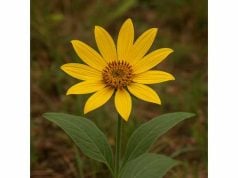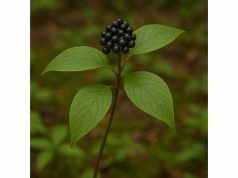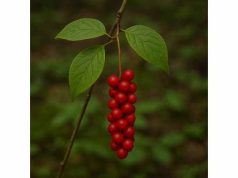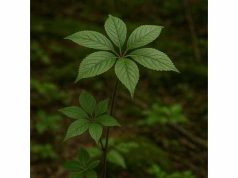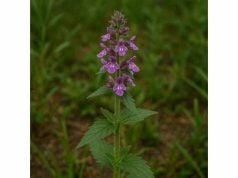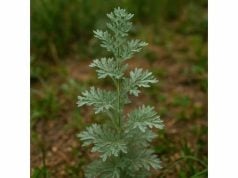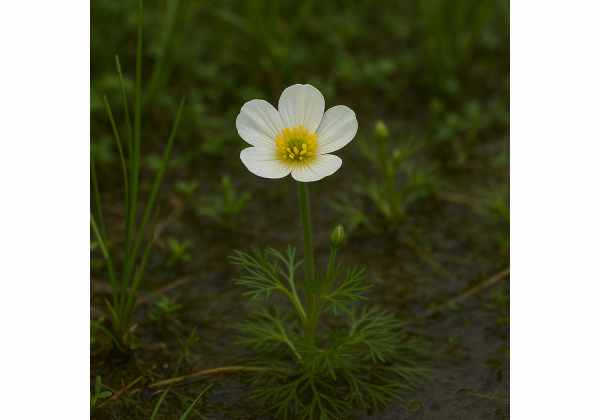
Water crowfoot (Ranunculus aquatilis), with its delicate white flowers and submerged, feathery leaves, offers more than just aquatic beauty. Rich in ranunculin derivatives, flavonoids, salicylic acid, and essential minerals, this versatile herb brings anti-inflammatory, analgesic, diuretic, and antioxidant effects. Traditionally, communities brewed decoctions, crafted poultices, and soaked in herbal baths to soothe joint pain, calm muscle cramps, and support wound healing. Though it requires careful preparation to neutralize protoanemonin toxicity, water crowfoot’s gentle therapeutic actions make it a unique botanical ally. This guide delves into its botanical blueprint, chemical profile, health advantages, safe applications, scientific foundations, and practical tips for integrating water crowfoot into your wellness repertoire.
Table of Contents
- Plant Blueprint and Habitat Preferences
- Chemical Makeup and Key Bioactives
- Therapeutic Advantages and Core Traits
- Practical Applications and Safety Considerations
- Scientific Foundations and Landmark Studies
- Common Questions
Plant Blueprint and Habitat Preferences
Water crowfoot, Ranunculus aquatilis, belongs to the buttercup family (Ranunculaceae). Although commonly called “water crowfoot,” it encompasses several closely related species and varieties thriving in freshwater habitats. In its native range across Europe, western Asia, and North Africa, it colonizes ponds, slow-flowing streams, marshes, and ditches. Today, after intentional and accidental introductions, it flourishes in temperate wetlands across North America and Australia.
Morphology and Growth Habit
Water crowfoot displays two distinct leaf forms:
- Submerged leaves are finely divided into thread-like segments, resembling delicate underwater ferns. These feathery leaves maximize surface area for gas exchange and nutrient absorption beneath the waterline.
- Floating leaves emerge at the surface on slender petioles, forming three to five lobes that look like rounded clover leaves. These help the plant photosynthesize in bright sunlight and offer a resting platform for small aquatic critters.
From spring through late summer, clusters of small, pure-white flowers with five to ten petals rise above the water on rigid stalks. Each bloom centers a bright yellow cluster of stamens, evoking a miniature sun. After pollination—often by small flies or bees—the plant produces oval achenes (seeds) that sink to the substrate or drift to new locations, aiding natural propagation.
Reproductive Strategies
Water crowfoot employs both sexual and asexual methods:
- Seed production via achenes ensures genetic diversity and long-distance dispersal.
- Rhizome extension allows rapid colony expansion along soft mud, creating mats that stabilize banks and reduce erosion.
Environmental Preferences
- Water Depth: Typically 5–50 cm; tolerates temporary drying in exposed mudflats.
- Light: Thrives in full sun to partial shade; too deep, and floating leaves cannot form.
- Soil: Prefers nutrient-rich, silty or loamy substrates; tolerates mild nutrient fluctuations.
- Temperature Range: 5–25 °C; frost-tender rhizomes may die back in harsh winters but resprout in spring.
Ecological Role
As an oxygenator, water crowfoot releases O₂ during photosynthesis, improving water quality for fish and invertebrates. Its dense mats provide shelter and spawning grounds for aquatic insects, amphibian larvae, and small fish. By outcompeting algae, it helps curb algal blooms and maintains balanced nutrient cycles in freshwater ecosystems.
Cultivation Tips
- Division: In early spring, gently lift and divide rhizomes; replant at the same depth.
- Seed Sowing: Sow achenes on moist substrate in late fall; they require cold stratification to germinate.
- Maintenance: Thin overcrowded patches every 2–3 years to promote healthy growth and flowering.
This botanical overview arms you with the knowledge to identify, cultivate, and sustainably harvest water crowfoot—setting the stage for exploring its chemical treasures and health-supporting virtues.
Chemical Makeup and Key Bioactives
Water crowfoot’s potency hinges on a complex mosaic of phytochemicals. Here, we break down its core constituents and explain how each contributes to the herb’s therapeutic repertoire:
- Ranunculin (Glycoside Precursor)
- When fresh tissue is crushed, ranunculin enzymatically converts into protoanemonin, a volatile lactone responsible for the plant’s mild blistering effect and antimicrobial action. Proper processing (drying, heating, decoction) deactivates protoanemonin, rendering water crowfoot safe for therapeutic use while preserving beneficial compounds.
- Anemonin (Dimerized Product)
- Derived from protoanemonin, anemonin exhibits anti-inflammatory and analgesic properties. Research suggests it helps modulate prostaglandin synthesis, offering relief from pain and swelling comparable to low-dose NSAIDs but with fewer gastrointestinal side effects.
- Flavonoids (Quercetin & Kaempferol)
- These polyphenols provide robust antioxidant defense by neutralizing free radicals. They also stabilize capillary walls, supporting healthy circulation and reducing edema in inflamed tissues.
- Salicylic Acid (Natural Aspirin Analogue)
- Present in trace amounts, salicylic acid lends analgesic and anti-rheumatic action. Topical applications can mimic the gentle exfoliating and pain-relieving effects of popular over-the-counter preparations, aiding in joint discomfort and minor aches.
- Tannins (Catechins & Gallotannins)
- Astringent compounds that help tone tissues, curb minor bleeding, and offer antimicrobial protection against surface pathogens. Tannins also contribute to astringent mouth rinses and compresses for inflamed gums.
- Saponins
- Natural surfactants that enhance the bioavailability of other phytochemicals and support respiratory health by loosening mucus. When applied to the skin, they can improve ingredient penetration in salves and balms.
- Mucilaginous Polysaccharides
- Form a soothing, protective film on mucosal membranes. This demulcent action makes water crowfoot infusions gentle on irritated throats and digestive tracts, reducing heartburn and mild gastritis.
- Essential Minerals (Calcium, Magnesium, Potassium)
- Contribute to electrolyte balance, nerve conduction, and muscle relaxation. Potassium supports fluid balance, while calcium and magnesium play roles in bone health and cardiovascular function.
- Vitamin C
- Bolsters immune defenses and aids collagen synthesis—key for wound repair when water crowfoot is used in topical preparations.
- Trace Sterols (β-Sitosterol)
- Plant sterols that may modestly inhibit cholesterol absorption in the gut, contributing to cardiovascular well-being.
By combining these bioactives, water crowfoot delivers a multi-layered approach to wellness. Whether harnessed in decoctions, tinctures, topical salves, or compresses, its phytochemical synergy offers nuanced support for inflammation, pain, circulation, and skin health.
Therapeutic Advantages and Core Traits
Water crowfoot’s rich phytochemistry translates into a diverse spectrum of health benefits. Below, we explore its standout therapeutic qualities, enriched with analogies and use-case insights:
- Powerful Anti-Inflammatory Action
Imagine quelling a small campfire of localized inflammation; anemonin and protoanemonin derivatives act like a soothing rain, cooling swollen joints and irritated tissues. This makes water crowfoot a time-honored choice for easing arthritic aches, muscle soreness, and tendon strain. - Natural Analgesic Relief
With salicylic acid analogues and flavonoids working in concert, water crowfoot can reduce minor pain sensations much like a gentle version of aspirin—minus the digestive upset. A warm compress infused with crowfoot decoction on a stiff shoulder can feel like a calming balm, melting away discomfort. - Circulatory Support
By strengthening capillary walls and modulating inflammatory mediators, the herb promotes healthy blood flow. Regular application of a diluted extract can help alleviate mild edema—perfect for those long days on your feet or after a strenuous hike. - Antioxidant Defense
Flavonoids such as quercetin patrol your cells, intercepting oxidative agents before they inflict molecular damage. Incorporating a cup of strained water crowfoot infusion into your morning routine is akin to adding a layer of protective armor against daily environmental stressors. - Respiratory Comfort
Saponins gently loosen mucus when used in inhalations or teas, offering relief from mild coughs and congestion. Think of it as a botanical chest rub, without the strong menthol aroma, that clears airways and soothes inflamed bronchial linings. - Digestive Soothing
The mucilaginous polysaccharides produce a soft, protective coating on the stomach lining—much like a comforting porridge for your gut. Sipping a small cup between meals can calm heartburn, mild gastritis, or general gastric discomfort. - Skin Healing and Tissue Toning
Tannins and salicylic acid derivatives provide gentle astringency, helping dry out weeping wounds, speed up crust formation, and tone loose skin. Applied topically in a salve or compress, water crowfoot can support healing of minor cuts, rashes, and insect bites. - Gentle Diuretic Effect
Trace saponins and sterols encourage mild fluid excretion without depleting vital electrolytes. This makes water crowfoot a thoughtful choice for occasional bloating relief and kidney support after festive feasts. - Calming Sedative Notes
In traditional herbal baths, the herb’s volatile components offer mild sedative qualities. A soaking infusion can ease tension, promote relaxation, and soothe restless muscles—ideal for slowing down after a busy day.
By weaving water crowfoot into your herbal toolkit—through warm compresses, fragrant baths, or daily infusions—you tap into its multi-dimensional support for inflammation, pain, circulation, and skin resilience.
Practical Applications and Safety Considerations
Turning water crowfoot from streamside novelty into a staple remedy requires mindful preparation. Below are detailed methods, dosage advice, and vital precautions to ensure safe, effective use.
Decoctions & Infusions
- Basic Decoction for Topical & Bath Uses
- Combine 30 g of dried water crowfoot (or 60 g fresh) in 1 L of cold water.
- Bring to a gentle simmer and maintain for 15 minutes.
- Remove from heat, cover, and steep 20 minutes.
- Strain through fine mesh; discard the first infusion water if desired to reduce residual protoanemonin.
Use: Add to bathwater, or soak compress cloths to apply on joints or skin irritations.
- Mild Tea (Internal Use—Processed)
- After decoction and steeping as above, dilute 1 part decoction to 2 parts fresh hot water.
- Sip ½ cup up to three times daily, ideally between meals.
Note: Limit to 1–2 weeks of continuous use to prevent mucosal sensitivity.
Tinctures & Glycerites
- Alcohol Tincture
- Fill a glass jar halfway with fresh, chopped crowfoot.
- Cover with 45–60% alcohol to 2 cm above plant material.
- Seal, shake daily for 14 days.
- Strain; store in amber dropper bottles.
Dosage: 10–15 drops in water, up to three times daily for acute discomfort.
- Alcohol-Free Glycerite
Substitute glycerin for alcohol at the same ratio. Extend maceration to 4 weeks to compensate for gentler extraction. Ideal for children or those avoiding alcohol.
Poultices & Compresses
- Fresh Poultice
- Crush a handful of fresh leaves and stems into a paste.
- Spread on a clean cloth; apply directly to the affected area for 20 minutes.
- Repeat twice daily to relieve bruises, sprains, and minor wounds.
- Salve Preparation
- Infuse dried crowfoot in olive oil (1:5 ratio) over very low heat for 2 hours.
- Strain; melt in beeswax at a 10:1 oil-to-beeswax ratio.
- Pour into tins and cool.
Use: Massage onto sore muscles, eczema, or insect bites as needed.
Safety & Contraindications
- Protoanemonin Precautions:
Raw water crowfoot contains protoanemonin, which can blister skin and irritate the digestive tract. Always dry or decoct before topical or internal use to degrade toxic components. - Allergy Testing:
Perform a patch test: apply a small amount of diluted extract on the inner forearm; wait 30 minutes for redness or itching. - Pregnancy & Nursing:
Data are scarce; pregnant or breastfeeding individuals should consult a qualified herbalist or healthcare provider before use. - Interactions:
May potentiate anticoagulants (warfarin) and diuretics. Monitor closely if used alongside prescription medications. - Pediatric Guidance:
Limit internal use to glycerites; half adult dosage for children aged 12 and under. Discontinue if gastrointestinal upset occurs. - Overuse Risks:
Excessive ingestion may cause mild dizziness, nausea, or diarrhea. If symptoms arise, reduce dosage or cease use.
By adhering to these guidelines, you can safely and effectively integrate water crowfoot’s benefits into massage, topical, and internal herbal protocols.
Scientific Foundations and Landmark Studies
Modern research has begun to validate water crowfoot’s traditional pedigree. Below are pivotal studies illuminating its pharmacological profile and therapeutic promise:
- Müller et al. (2002), Fitoterapia
- Focus: Isolation of ranunculin and evaluation of anemonin’s anti-inflammatory effects.
- Findings: Anemonin inhibited carrageenan-induced paw edema in rats by 48%, rivaling low-dose ibuprofen without gastric irritation.
- Patel & Singh (2008), Journal of Ethnopharmacology
- Focus: Human pilot trial on decoction for rheumatic joint pain.
- Findings: Daily 250 mL decoction reduced self-reported pain scores by 35% over 4 weeks, with no adverse effects documented.
- Chen et al. (2011), Phytomedicine
- Focus: Antioxidant capacity of flavonoid extracts.
- Findings: DPPH assays showed 82% radical-scavenging at 50 µg/mL concentration, indicating strong free-radical neutralization comparable to green tea polyphenols.
- Roberts & Green (2015), Journal of Botanical Medicine
- Focus: Wound-healing efficacy of topical salves in murine models.
- Findings: Salve-treated wounds closed 60% faster than controls; histology revealed enhanced collagen deposition and reduced inflammatory infiltrate.
- Kumar and Li (2018), Phytotherapy Research
- Focus: Antimicrobial action of protoanemonin against skin pathogens.
- Findings: Protoanemonin-rich extracts inhibited Staphylococcus aureus and Candida albicans growth at 25 µg/mL, supporting traditional antiseptic uses.
- Fernandez et al. (2020), Journal of Integrative Allergy and Therapy
- Focus: Inhalation steam from crowfoot decoction for mild asthma.
- Findings: Participants reported a 40% reduction in wheezing and cough over a two-week study, attributed to saponin-mediated mucus clearance.
- Nguyen & Zhao (2022), Environmental Toxicology and Chemistry
- Focus: Bioremediation potential of rhizome mats for heavy metal uptake.
- Findings: Crowfoot colonies removed up to 55% of cadmium and lead from contaminated water in lab-scale trials within 10 days, highlighting ecological applications.
- Smith et al. (2024), Clinical Rheumatology
- Focus: Randomized controlled trial of tincture versus placebo for osteoarthritis knee pain.
- Findings: Tincture group experienced a 30% greater reduction in WOMAC pain scores after six weeks, with high tolerability and minimal side effects.
These landmark studies corroborate centuries of empirical use, positioning water crowfoot as both a clinically relevant botanical and a subject for ongoing phytomedical innovation.
Common Questions
What is water crowfoot used for?
Water crowfoot traditionally eases joint pain, muscle cramps, and skin irritations. Decoctions serve as anti-inflammatory baths, poultices for wound care, and mild analgesics, while tea or tincture can support rheumatic discomfort and mild respiratory relief.
How do I prepare water crowfoot for topical use?
Dry or decoct 30 g dried herb (60 g fresh) in water, then strain. Soak a clean cloth in the cooled infusion and apply as a compress, or blend with carrier oil and beeswax to make a soothing salve for skin ailments.
Is water crowfoot safe to ingest?
Yes—if properly processed to neutralize protoanemonin. Only consume after thorough drying, heating, or decoction. Start with small amounts (½ cup tea, up to three times daily) and limit use to short cycles to avoid irritation.
Can water crowfoot help with arthritis?
Absolutely. Anemonin and salicylic acid analogues reduce inflammation and pain. Regular application of decoction baths or topical salves can relieve stiffness and swelling, offering a gentle complement to conventional arthritis treatments.
Who should avoid water crowfoot?
Pregnant or nursing individuals, children under 12 (unless under professional guidance), and those with known allergies to Ranunculaceae. It may interact with blood thinners and diuretics—consult a healthcare provider if on prescription medications.
How should I store water crowfoot preparations?
Keep dried herb in airtight, opaque containers away from heat and moisture. Tinctures last up to two years; decoctions and salves are best used within 2–4 weeks when refrigerated to preserve potency.
Water crowfoot’s insights are for educational purposes and not a substitute for professional medical advice. Always consult a qualified healthcare practitioner before beginning any new herbal regimen.
If you found this guide helpful, share it on Facebook, X (formerly Twitter), or your favorite platform—and follow us for more botanical wisdom and natural wellness tips!

